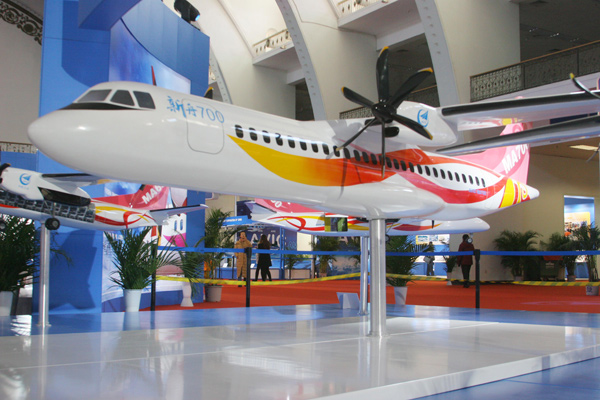AVIC unveils plan for next-generation regional aircraft
Updated: 2013-12-20 02:24
By Zhao Lei (China Daily)
|
|||||||||||
|
 |
|
A model of the next-generation turboprop MA-700 regional airliner is on display at an air show in 2009. Aviation Industry Corp of China, a major Chinese aircraft manufacturer, said on Thursday it will complete the design of the 78-seat airliner next year. Its maiden flight is slated for 2016.[Photo / China Daily] |
Dong Jianhong, chief designer of the aircraft at Aviation Industry Corp of China, the nation's largest aircraft manufacturer, said at a news conference in Beijing that the next-generation turboprop, the 78-seat MA-700, will serve regional air transportation within an 800-km range and be able to fly at high altitudes and in high temperatures.
He said the AVIC turboprop will have a cutting-edge design, low operation and maintenance costs, eco-friendly technology and rigorous safety standards.
"The safety standards we adopt will be even stricter than those of civil aviation authorities in China and other nations," Dong added. "We also designed a spacious place for each passenger that is larger than that of other aircraft of its kind."
The aircraft will have the most advanced flight control system — fly-by-wire technology — its first use on a turboprop aircraft.
The designer said the MA-700 will be able to carry a payload of up to 8.6 metric tons and fly 610 km per hour.
The plane's design is expected to be finalized next year, and its maiden flight is set for 2016.
The aircraft will be delivered to buyers in 2018, he said.
Before the new aircraft, AVIC developed the MA-60 turboprop regional airliner and its upgrade variant, the MA-600.
Eighty-eight MA-60s or MA-600s have been delivered to 24 buyers from 16 nations in Asia, South America and Africa, said Pang Zhen, head of AVIC's civil aircraft development.
The rising cost of aviation fuel has put airlines under heavy pressure, making turboprop aircraft, which consume less fuel than turbofan jets, more attractive.
Pang said the global market will need at least 2,900 turboprop regional airliners in the next 20 years, and China will need nearly 350 during this period.
China has nearly 2,000 airliners, 92 percent of which are large aircraft that have more than 100 seats. The situation forces carriers to use large planes to conduct short-distance flights or even abandon short-haul routes, leading to economic losses, Pang said.
Liu Jieyin, executive vice-president of Beijing-based Okair Airlines, echoed Pang's remarks on the need for more turboprops. Airlines are usually reluctant to use large aircraft to perform short-distance flights because it accelerates wear and tear on engines and other costly equipment while making only small profits, Liu said.
Meanwhile, taking regional aircraft for short trips is more convenient for travelers than other forms of transportation, which plays into the huge demand for such planes, he said.
"Say you want to travel from Yantai in Shandong province to Dalian in Liaoning province. An MA-60 makes the flight in 45 minutes, but it takes six to seven hours if you go by ship."
Liu said his company has signed an agreement with AVIC to procure 50 MA-series aircraft, including the MA-700 and its variants.
Geng Ruguang, AVIC deputy general manager, said the company has commissioned consulting agencies to survey 112 potential users and will consider their requests and suggestions in the design process.
The MA-700 platform will also be refitted to serve multiple purposes such as medical service, search and rescue, maritime surveillance and scientific experiments, he added.
Today's Top News
Yanukovich offers Ukraine protesters nothing
Putin says to pardon jailed tycoon Khodorkovsky
China, Britain face new opportunities
Military plays down naval 'near-miss'
Overseas investing sees large jump
Twin goals drive subway fare rise
More protection for Sanjiangyuan
Monaco and Shanghai jointly to grow yachting biz
Hot Topics
Lunar probe , China growth forecasts, Emission rules get tougher, China seen through 'colored lens', International board,
Editor's Picks

|

|

|

|

|

|





